Running an in-depth brand mentions audit could help you make sure that you are not overlooking any efficient strategies that might be working wonders for your competitors. There might be many ways in which you can boost your business, but the truth is that the more you can find out about your niche and your competitors, the more you can learn, adapt and ultimately flourish.
Therefore, by doing a bit of reverse engineering, let’s see how doing an effective brand audit can help you uncover your competitors’ strategies and of course, boost your rankings.
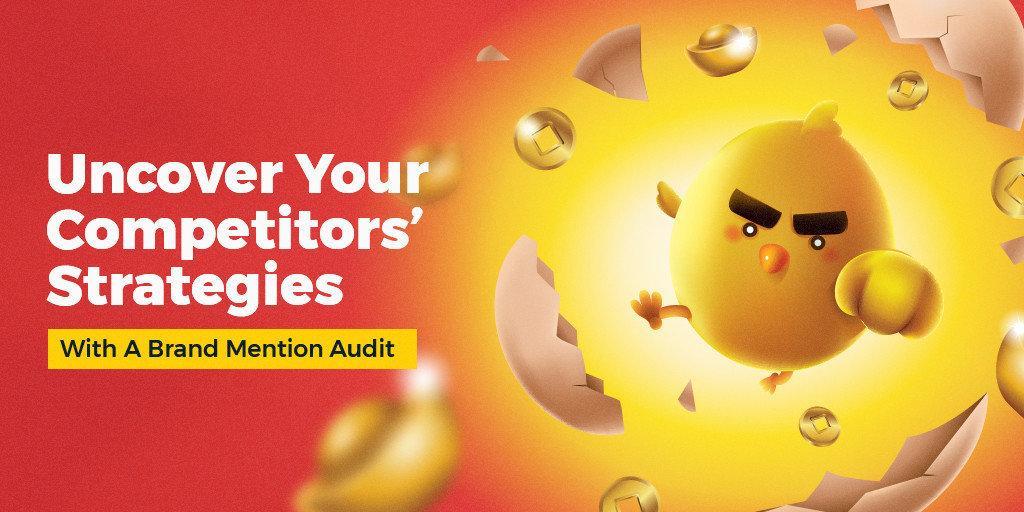
- How to Identify and Research Your Competitors
- How to Find the Most Popular Brand in Your Niche
- Unveiling Each Competitor’s Strategy
- Conclusion
1. How to Identify and Research Your Competitors
Researching your brand and your competitors might be easier said than done, we know. Yet, when you have the right tools at your disposal, things get easier.
And, as the old saying goes, I hear I forget, I see I remember, I do I understand, let’s take some real examples to work with.
When it comes to your brand, things are quite clear as you know who your main competitors are. And if you don’t, you can run an in-depth audit to get a thorough competitor analysis. As mentioned before, when you have the right tools at hand, things get a bit easier. And this is the brand audit process:
Step One: Identify Competitors’ Rankings on the Keywords You Target
Let’s say that our brand is “The Body Shop” (no, dear readers, our brand is not The Body Shop and we cannot offer you free product samples; only cognitiveSEO free trials).
So, we are The Body Shop and we have no idea of our competitors. What to do?
A quick search on the free tool Site Explorer will set things clear. We will find a great deal of data on our own brand. The number of links, where they are coming from, linking opportunities, etc.
Yet, for the moment, our interest is to figure out who our competitors are. Also, you can see how they are currently positioned (comparing to you). And to do so, we checked out our top 20 ranking keywords. This info is literally one click away.
Among other keywords, we can see that we are ranking for the “face mask” keyword, a term with a high search volume and a significant traffic index. Therefore, if this is such a competitive keyword, for sure it’s “hunted” by some big competitors as well.
Step Two: Analyze the Top Rankings for Your Queries of Interest
So, who are the players that aim for the same keywords as we do?
To figure this out, we go to the Keyword Tool & Content Assistant and check the top rankings for this particular keyword: “face mask”.
We took a look at the first five positions only, but you can see up to the first 100 pages ranking on the keyword you are interested in.
While the first two positions are held by some big resellers, some big players appear in the following positions: Sephora and Lush. Both aiming for the same keyword as we are. Therefore, just at a glance, we discovered some important competitors.
Step Three: Spy on Your Competitors’ Strategies
Once you know your competitors, you need to take an in-depth look at what they’re doing.
The more you can find out about your business and your competitors, the more you can learn, adapt and ultimately flourish.
In this third brand audit step, you must follow the next important points when you research your competitors:
- identify missed opportunities;
- find your (or your competitors’) weaknesses (SWOT analysis);
- spot new strategies and fill in the ranking gaps;
- get an in-depth understanding of your competitors’ content strategy;
- get a better grasp on the dynamic of your organic position in relation to your competitors.
You can find each of these points detailed in a previous article of ours, on how to uncover your competitors’ SEO strategies.
You can easily acquire some brand insights just by taking a quick look at what the competition is doing in terms of SEO strategy. Afterwards, you can figure out some opportunities. Where are your competitors linking? What is their overall approach when it comes to SEO? What is their content marketing strategy? How visible are they on Google?
Let’s take a look at the screenshots below. When you’re only monitoring your brand of interest, it seems that The Body Shop is on an ascending trend and it’s becoming more and more visible each day. Which is great.
But what happens if we contextualize things a bit and move our eyes a little lower, to the next screenshot? thebodyshop.com doesn’t seem to be that successful when it comes to compare it with its competitors.
Sometimes, context is the key – from that comes the understanding of everything.
It’s always interesting to take a look at the site’s link profile. As we can see in the screenshot below, Sephora seems to be the leader in terms of number of links. Don’t forget that studying the competitor’s link profile can bring many great link opportunities.
Quick Tip: Perhaps the easiest way to take advantage of your competitor’s link profile is to crawl your competitor’s broken backlinks and, using the Link Reclamation Technique, try to “borrow” its link juice to get higher traffic and rankings.
2. How to Find the Most Popular Brand in Your Niche
The first part is now completed. We’ve identified the competitors and we already have an overall idea of how we’re standing in our niche from an SEO point of view.
Yet, how do we know which one is the most popular?
Rankings and popularity don’t always go hand in hand.
So, if we’ve already cleared things up in terms of SEO visibility, let’s figure out how we can identify key competitors in any niche.
(You can find more about rankings and popularity in this great article, “Authority vs. popularity in search engine rankings.”)
For those of you who are reading this chapter only, I will repeat that, without having any affiliation with this niche or its competitors, we’ve taken a deep look at the cosmetics market. After a quick competitive analysis, from the sea of strong brands, we’ve picked for our research The Body Shop and their competitors discovered in the steps above.
Therefore, the brands that we will be looking at are:
- Yves Rocher
- The Body Shop
- Sephora
- Lush
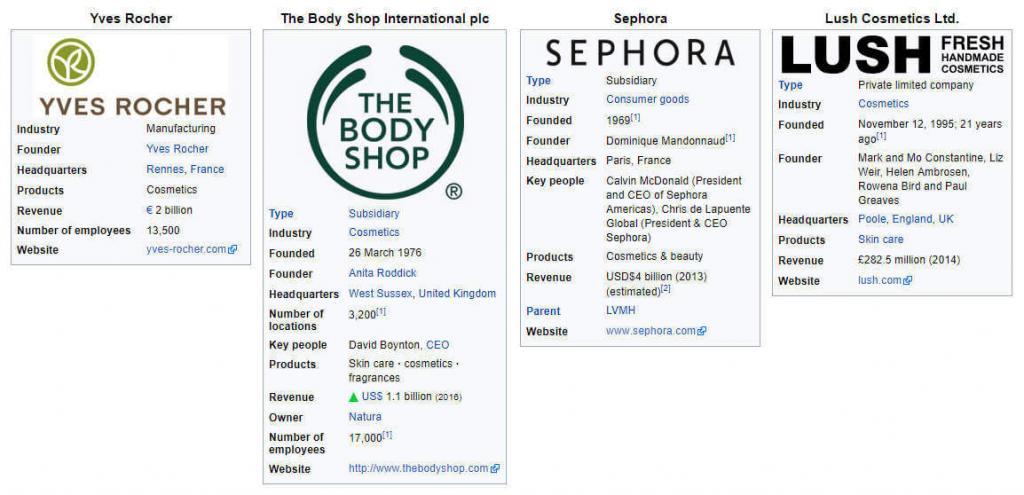
These are all world-class brands with no shortage of customers. But is there still something to learn from their media presence?
Google Trends – a Great Tool for Topics but Not for Brands
Finding the most popular player or the one who performs best on the web is quite a difficult task without having the proper tools.
You can try figuring out which is the most trending, yet Google Trends will only give you relative and not absolute data.
When it comes to searching big topics (USA elections, Oscars, Valentine’s Day, etc), Google Trends can be of real help. But when it comes to brands, things get complicated.
Google Trends aggregates data from Google Search, YouTube and Google News, and ranks the most searched for stories. It could be one of the most comprehensive trends aggregate you’ll find on the web as by watching spikes in search terms during major events, you can quickly determine which topics are grabbing people’s interest.
When you are looking for some particular brands in a niche, it doesn’t bring much added-value to your research as the data is not very helpful.
As you can see in the screenshot below, where the beauty brands that we took for analysis are compared within Google Trends, we are only offered a relative interest over time and not a complete picture of what’s going on. Interpreting analytics effectively to gain useful insights about your customers is no easy task.
Customer behavior can easily become lost in the math behind results or overlooked and simply taken at face value.
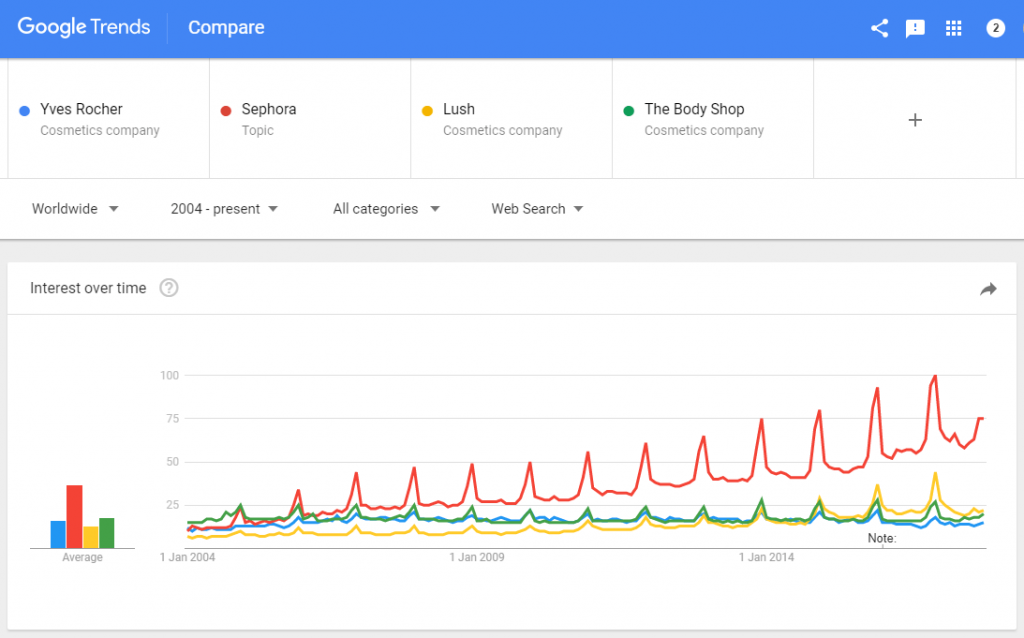
BrandMentions – Find Who Is the Most Popular Brand in Your Niche
Popularity is the state or condition of being liked, admired, or supported by many people. Justin Bieber is popular among young people because they are talking a lot about him and he is mentioned (most likely) daily in all types of media.
Most popular = most mentioned
Therefore, in order to find the most popular brand within our niche, we need to find out the most mentioned one.
Here is where BrandMentions takes the floor.
Since we are interested in the best player out of the 4 brands, Yves Rocher, The Body Shop, Sephora and Lush, we used the BrandMentions tool to identify the exact number of mentions each brand has in order to measure their online popularity.
Judging just by the number of mentions from the last month from the UK market only, as we see in the screenshot below, the winner is Sephora, followed by Lush, Yves Rocher and The Body Shop.
Numbers are indeed a great indicator, yet, we can go a bit further with our research and see how the 4 brands performed throughout the month on a worldwide level.
Again, when contextualizing a bit, things tend to change. The big winner in terms of number of mentions is Lush this time. Yet, what is even more interesting is the way the number of mentions evolved by day for the all four brands. While The Body Shop, for instance, is more constant in the number of mentions, Sephora has some big ups and downs on a day to day level.
Spotting their highs and lows might tell us a lot about their strategy, their online presence and their popularity.
3. Unveiling Each Competitor’s Strategy
It seems like all four brands are very active, if we look at the high number of mentions each has. Even if The Body Shop has considerably fewer mentions than Sephora, for instance, it still has a lot of fresh mentions on a daily basis, as we can see in the chart above.
Numbers are important, yet there are a lot of things we can learn from the type of mentions themselves. Each mention has a main performance score, a domain authority score and a number of shares. When trying to find the best practices from the competitor’s strategy, these criteria are of great importance. And having access to all these data is of paramount importance.
By filtering the mentions by country, language or date, we can also uncover:
Does a brand have a strong presence in a certain country? Are the mentions written in English only? How is the brand standing in terms of the number of mentions in the last 24 hours?
The Mentions Type
Looking at the chart from above with the number of mentions side by side, we couldn’t help observing the web – social mention ratio for each brand. And it goes something like this:
-
The Body Shop – 10% Web Mentions; 90% Social Mentions
-
Yves Rocher – 9% Web Mentions; 91% Social Mentions
-
Sephora – 3% Web Mentions; 97% Social Mentions
-
Lush – 2% Web Mentions; 98% Social Mentions
Therefore, at just a glance, we can get an idea of how the beauty brands niche works but also on each brand strategy in particular. It seems like the social activity is powerful, being the most important source of mentions for each analyzed brand. With more than 90% of all mentions coming from social media, the question is not whether these brands use social media but how well they do it.
Let’s assume again that we are The Body Shop and we want to check out what our competitors are doing in order to outrank them. So let’s take a look at Sephora, for instance. For a better understanding of their strategy, we can choose to look only at their highly performing social mentions.
Where are these mentions coming from? Can we get inspired by their strategy? Can we fill in some gaps on the beauty niche?
We can get an answer to these questions just by taking a look at our competitors’ mentions source and their performance.

The Mentions Performance
The performance score of each mention is calculated based on the number of shares and the domains authority. Therefore, the number of mentions and their source is of high importance.
It’s true that all mentions matter, but some of them matter most than others.
When looking into the competitor’s yard, we tend to look at its best practices and try to replicate what worked best for them.
The beauty brand Lush seems to remain the indisputable leader when it comes to high-performance mentions. What is very interesting is that Sephora, which does not perform as well in terms of mentions number, is the second best when it comes to mentions with very high-performance score.

The Mentions Shares
We’ve realized that the relationship between the number of mentions and volumes of shares is hardly linear. It looks something like this:
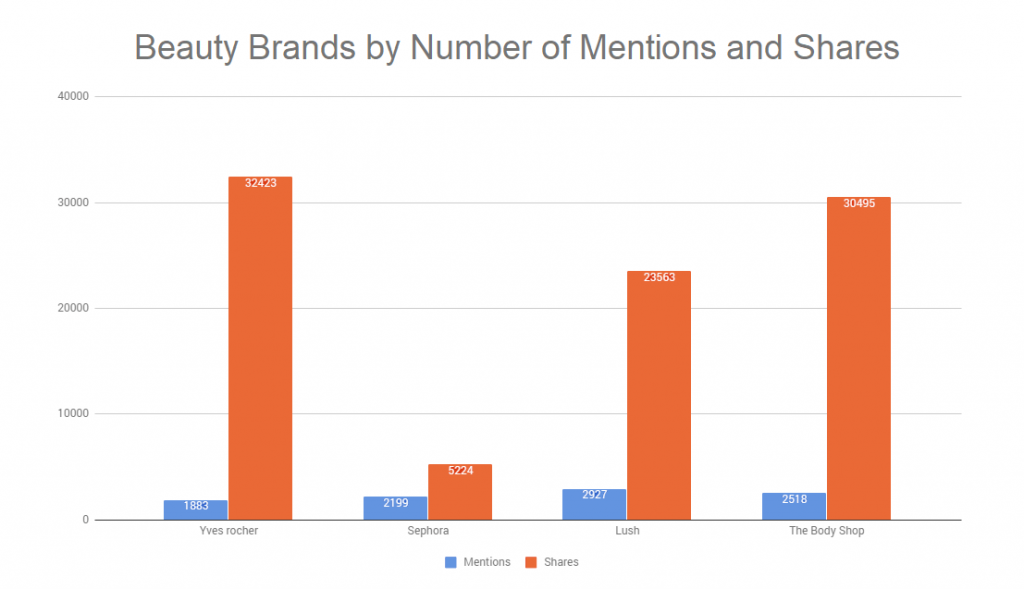
Therefore, even if for the analyzed period of time Yves Rocher didn’t have the most mentions, it’s interesting to see how that it had the most shares.
It’s getting harder and harder to adjudicate a winner now, right?
The Strategies Exposed – Who Talks About Your Competitors and Where
We cannot claim to understand our beauty brands’ mentions trend without taking into consideration the source of the mentions. Anytime people talk about us or our professional achievements is great. However, although it is nice to capture peoples’ attention, it often occurs that some opinions are valued more than others. If I were a physicist, I am sure that my family’s appreciation on my work would have mattered, yet, not as much as an opinion coming from Stephen Hawking.
We already have an idea of the mentions type and performance each of our competitors has. Yet, what makes them so popular? Who is talking about them so loudly that everyone can hear?
Yves Rocher
The French cosmetics brand doesn’t impress only with the sheer number of mentions, but also in terms of “volumes”. Set aside the Live Stream golden-egg-laying-goose, there’s still plenty to look at: close to 33,000 shares in total, as we can see in the screenshot above. Yet, where are these shares and mentions coming from?
The simple answer would be: from everywhere. With mentions in well-known publications from all over the world, there is no wonder Yves Rocher is so popular. The brand has worldwide coverage, getting mentions in great authority magazines, such as Fashion or Femme.
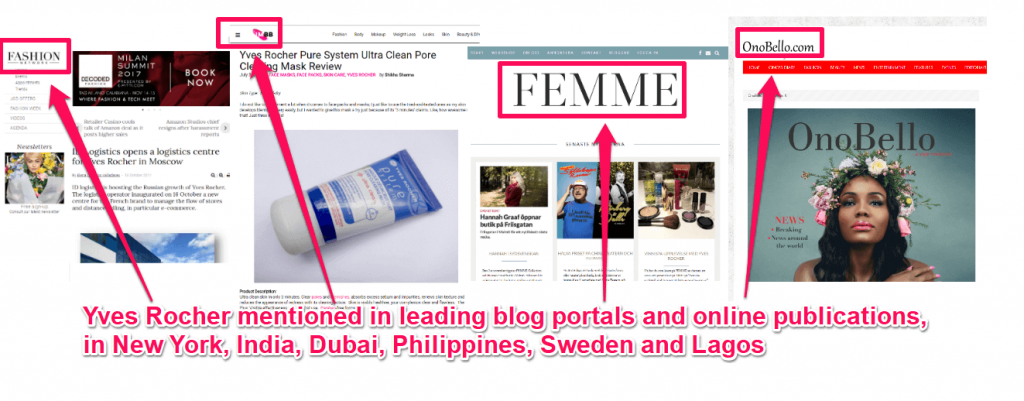
Sephora
The French chain of cosmetics Sephora impresses by the high number of mentions received in publications such as Cosmopolitan, Glamour or even ABC News. The amount of authority it got from there? Huge!
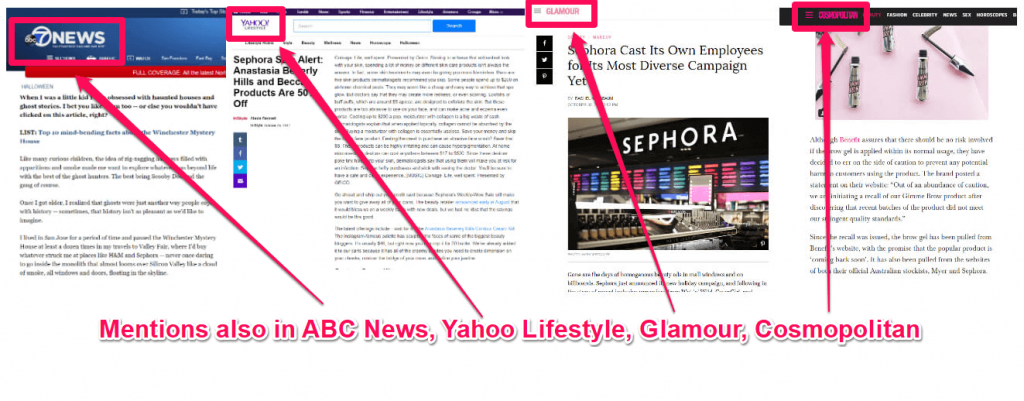
What it’s even more interesting is the amount of shares it manages to get in one day only. We made the screenshot below the day that the blogspot was published. After only a couple of hours from the publishing, the Sephora mention got over 1,000 shares. So, for all you cosmetic brands out there, you might want to be mentioned by Kristina Rodulfo, Associate Editor at ELLE.
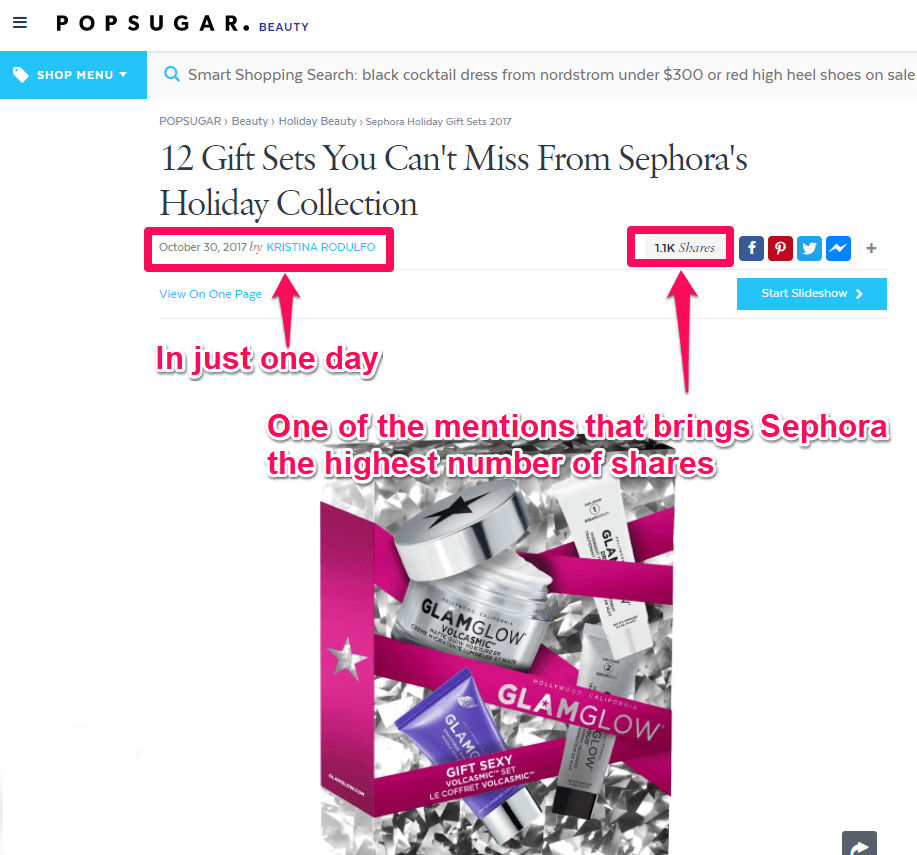
Lush
The UK cosmetics company Lush is not doing bad either when it comes to getting mentioned in well-known publications. The Independent, for instance, is a British online newspaper with a big tradition and millions of fans. Mirror is also a well-known tabloid. Therefore, having mentions here will guarantee a part of Lush’s popularity.
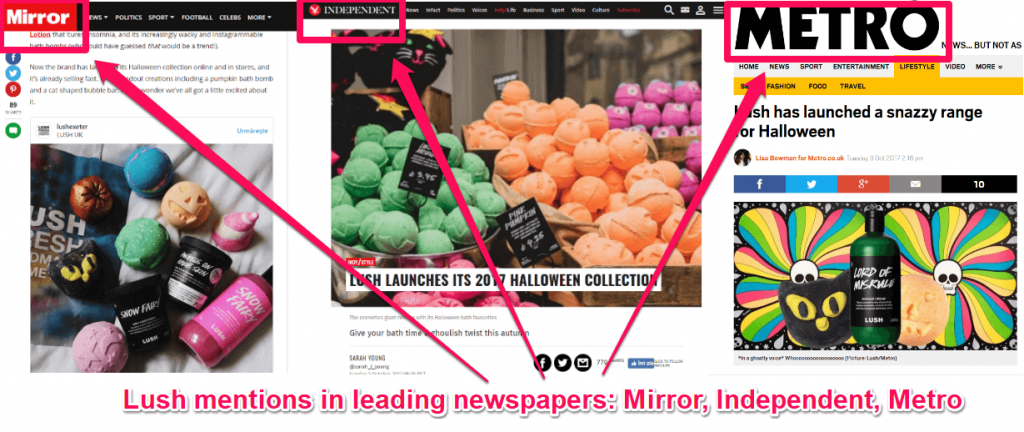
The Body Shop
Most likely everyone heard of Elle, the worldwide lifestyle magazine…or at least anyone interested in the fashion – cosmetics niche. What you need to know about it is that this publication is a well-known and popular magazine worldwide. So, having a mention here could be compared with having links from .edu websites. Even though The Body Shop does not not excel in terms of the volume of mentions when compared to its competitors, it’s doing OK when it comes to qualitative mentions.
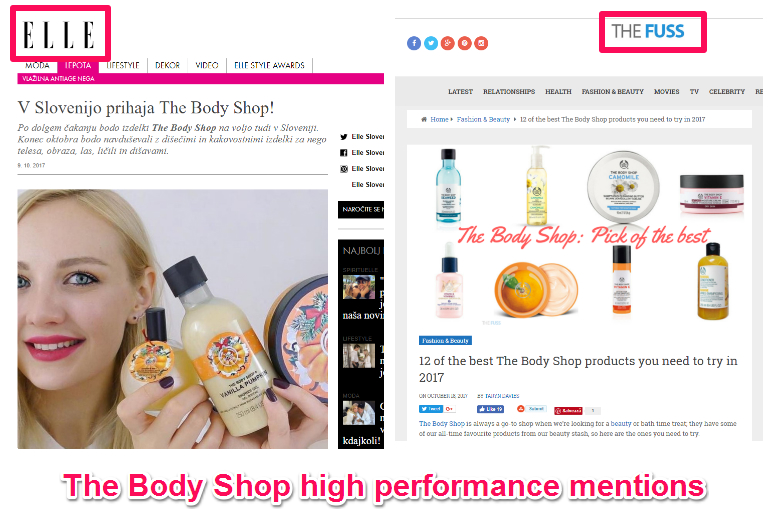
Conclusion
Having a lot of mentions of your brand on the web and basically earning media attention is a great asset. Yet, it is just half of the battle. Knowing where brand mentions come from and understanding which pieces of content drive a brand is the other half of the battle, and it is just as important as the first one.
There is no secret that niche and brand audits are a must for every business that wants to succeed in the ever-changing online environment and that they are the first step in the development of any digital marketing plan. We all want to know as much as possible from the niche we are competing in, whether we are a well-established business or a small company that wants to expand into new markets. And we cannot say enough that the more you can find out about your competitors, the more you can learn, adapt and flourish.
Although it may take a lot of time and energy, such a brand mention audit will eventually pay off. Think of the perspective that any of the analyzed brands could have if they were aware of what their competitors are doing, their strategic plan. They can see what type of content is working for their competitor and where they can replicate that success to their advantage.
Which publications are the most authoritative in the niche, and whose attention should you grab? Which social networks are most interested in this niche, and what type of content is working on each of them? Which country should we concentrate our efforts on? Is there a market for non-English speakers as well?
All of these are ideas which, put together in a digital marketing strategy, will probably not make overnight miracles, but constantly and consistently boost any brand.It is a good exercise to audit your brand beside your competitors.
The post How to Identify Competitors and Uncover Their Strategies with a Brand Mention Audit appeared first on SEO Blog | cognitiveSEO Blog on SEO Tactics & Strategies.
How to Identify Competitors and Uncover Their Strategies with a Brand Mention Audit posted first on http://nickpontemarketing.tumblr.com/
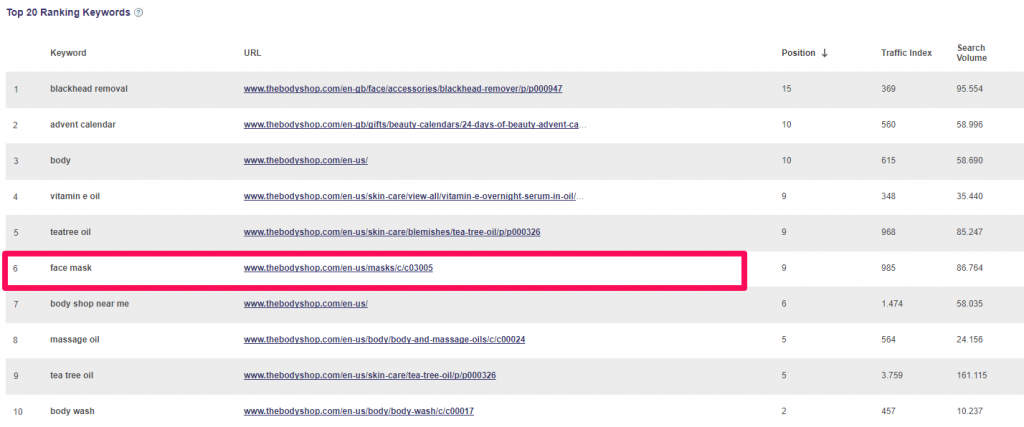

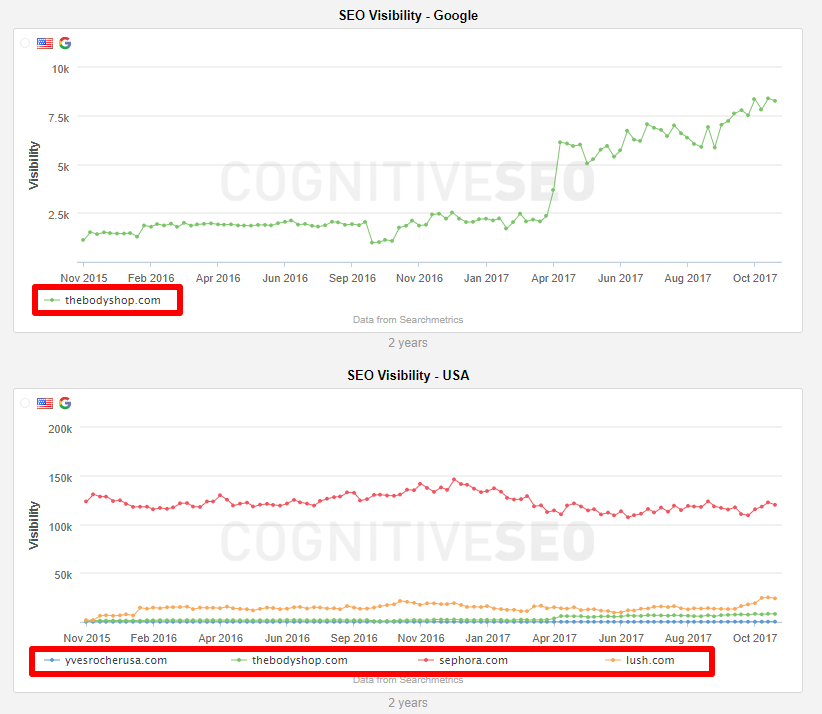
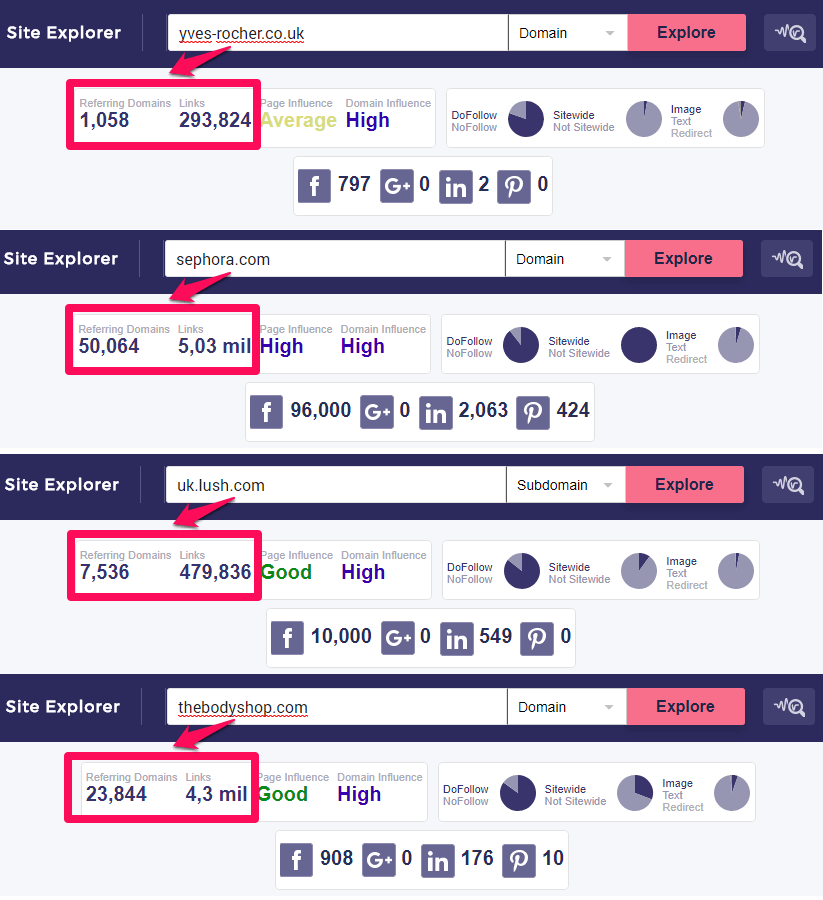
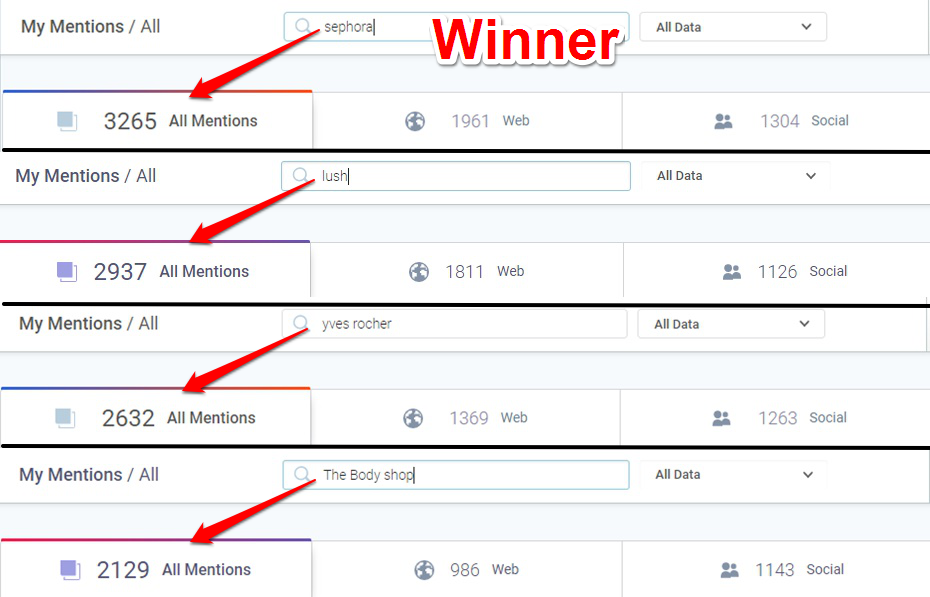
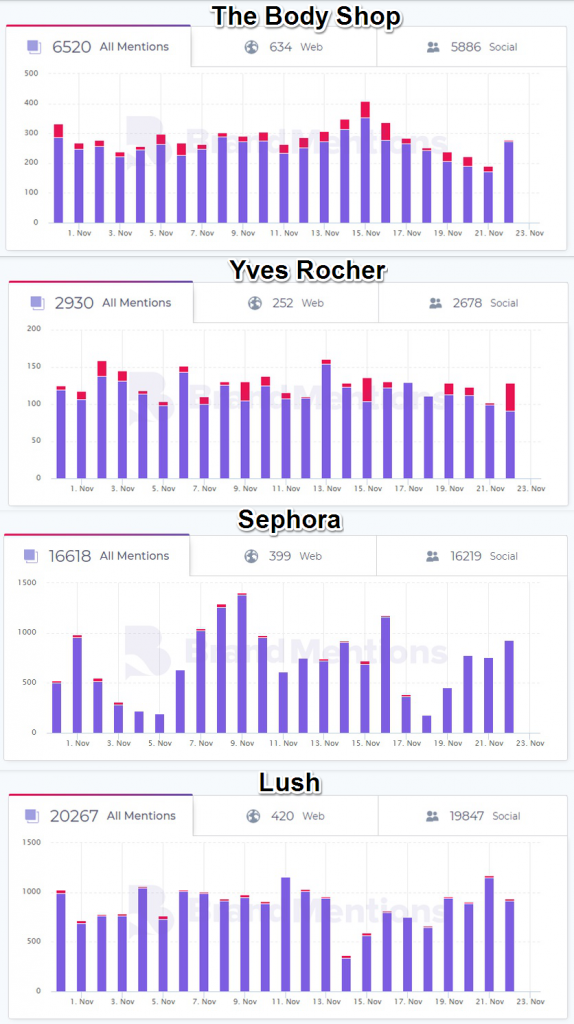

No comments:
Post a Comment